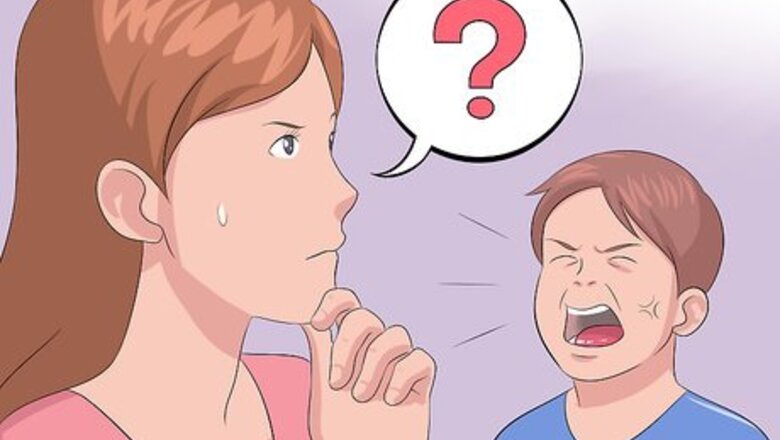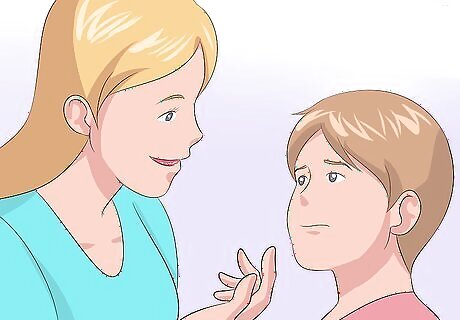
views
Understanding Why Your Toddler is Fake Crying

Ask yourself whether your toddler is fake crying to get attention. Toddlers fake cry for a variety of reasons, but it most often is to get a reaction from their parents. When you understand why they are fake crying, you can tailor your reaction to meet their needs. Many toddlers fake cry to get attention if they are competing with other siblings. Some toddlers begin fake crying at the birth of a young sibling or if they are often around infants. They see parents attending to the needs of a crying baby and think they have to cry to get attention as well. If this is the case, make sure to give your toddler some undivided attention at a certain time each day and teach them that they can be rewarded with attention for good behavior, not bad.

Think about whether your toddler is fake crying to get their own way. If a toddler wants something, like a new toy, and a parent isn’t giving in, many toddlers will begin to fake cry and cause a scene. This often happens in public, where toddlers realize they have other people on their side by creating a stir in front of an audience. Toddlers are at the age where they realize the power their actions have over other people, and they are realizing they can manipulate people with different actions. By fake crying, they are trying to use their actions to purposefully get what they want.

Be aware that your toddler may be fake crying as a way to express themselves. Fake crying is also common in less verbal children who have difficult time expressing themselves. Teach your child the importance of words and that you will only respond to their words, not their fake tears.

Consider whether your toddler is fake crying as a reaction to changes in their routine. Children who have experienced changes, such as divorce, moving to a new house, or getting a new pet, sibling or babysitter, are also more prone to fake crying. In these instances, the fake crying will usually stop once they get back into a routine.
Reacting to Your Toddler

Try to ignore the crying. Fake tears are often a phase which can be eliminated by simply ignoring your child’s crying. Check to make sure they aren’t hurt or in danger, but then leave them alone. Without a reaction, most children will stop fake crying. Any action that regularly gets a response from parents will be repeated over and over. To nip things in the bud, never respond to your child’s fake tears. Once you respond, the habit is much more difficult for toddlers to break. If ignoring your child doesn’t work and the crying continues to get worse and worse, it is time to take action. Simple responses to fake crying can teach your child that it doesn’t give them the reaction they want and that there are other ways to get attention.

Ask your child what's wrong. Younger toddlers have a hard time expressing their emotions, and fake crying may be an easier way for them to get attention and react to a problem. If this is the case, try to calm your child down by asking questions like “Are you OK?” and “What’s the matter?” Simple questions can encourage your child to talk about the issue instead of just faking tears.

Distract the child from their fake crying. If your child is throwing a fake crying tantrum and can’t be stopped, try distracting him with a question, or a funny song or story. If you ask the child a riddle or a question or sing their favorite song, most children will stop what they are doing to join in. Before you know it, you can have a happy and tear-free child.

Call them out on their fake crying. Sometimes, you can stop your child's fake crying by calling them out on the fact that they're faking it. In a calm but stern voice, say things like “I know those aren’t real tears” or “Are you just trying to wake your sister?”. Done on occasion, calling a toddler out can surprise them enough to snap them out of the fake tears.

Discipline your child if the fake crying continues. If fake crying becomes a regular problem that isn’t going away, sit your child down and explain to him the proper way to get attention. Tell him that crying is only for emergencies or when they are sad or hurt. Establish clear rules about not fake crying, and then follow through with the consequences. Use your judgment to determine the right discipline for your child—if could be taking away a favorite toy or limiting the time they can spend with their friends. When a child sees that fake crying gets them negative attention, they are more likely to stop.
Preventing Fake Crying

Create a calm environment. Fake crying is less likely to occur in a calm and attentive environment. That isn’t to say that parents with calm homes never have toddlers who fake cry, but it can help minimize the occurrence. Create an environment where your child feels loved and appreciated. Set aside a certain time everyday to have one-on-one time with your child and establish a connection with him. If he sees he gets your attention for a certain activity or time each day, he may be less likely to fake cry to get your attention.

Don't overreact when your child fake cries. Staying calm when your child fake cries will also help them grow out of the phase more quickly. Even if you ignore the crying and talk to them about something else, a toddler will be able to tell if you are stressed or angry by your face or your voice. Stay calm and positive to encourage them to move to a different activity.




















Comments
0 comment